








|
 |

|
 |

|
 |

|

|
This workflow action assigns a task to a specified user. To complete the task, the user must provide a value for each data item specified in the action configuration. The workflow will wait for the task to be completed before continuing the execution. Once the task is completed, the data that the user entered is available within the workflow.
To use the workflow action:
Alternatively
To change the settings used by the action:
For more information on the other options in the drop-down, please refer to the Getting started with the Nintex Workflow designer.
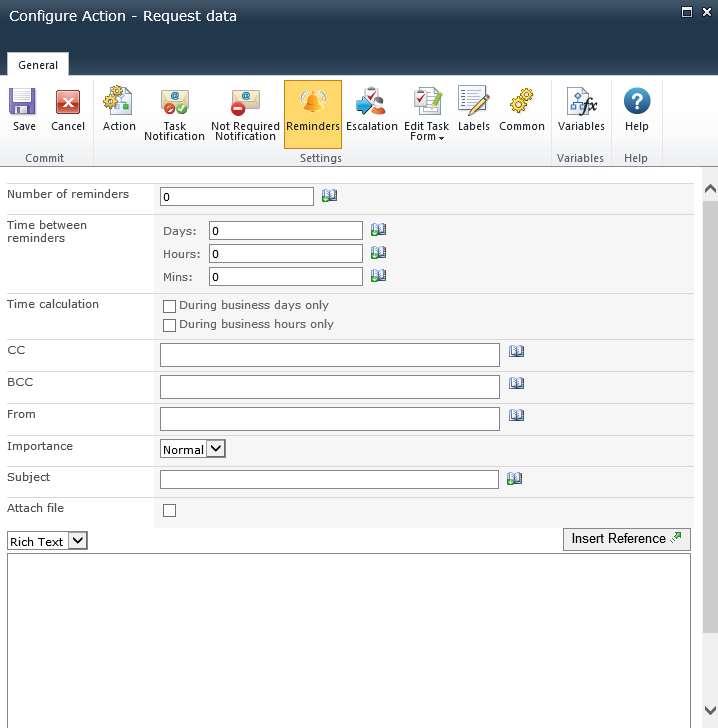
The user or group to retrieve data from. This task can only be assigned to a single user or group. If it is assigned to a group, the first group member to respond will act on behalf of the entire group.
Note: Although the People Picker field will allow multiple users to be added, the first person added will be the only person notified and the only person who can approve the task. If a group is added, all will receive the notification, but only one person will be able to respond. This is because the workflow action will only create a single task, and only one user will be able to respond to the task. Also, once one person responds to the task, the task will be completed and the other user will not be able to provide input.
To search for users, click on the address book icon on the right.
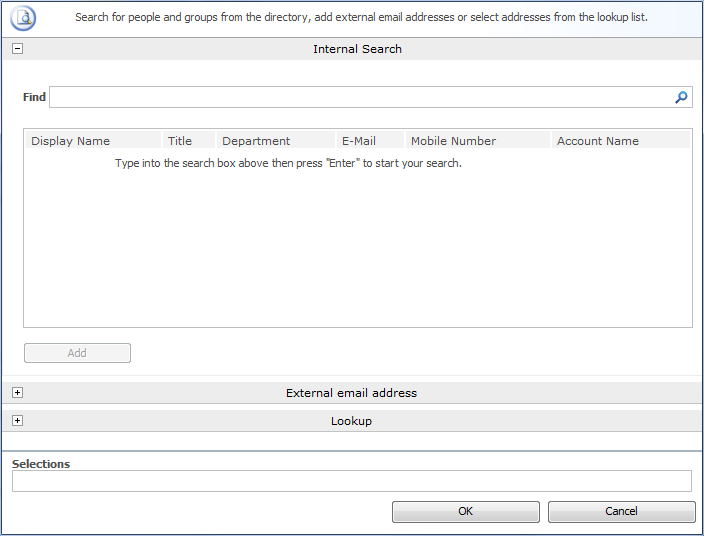
The configuration dialog allows the workflow designer to search for and/or add users to the Assignees list by one or more of the following methods:
- Internal Search: Entering a partial display name, email or user account name and clicking on the magnifying glass will provide a list of matching users and groups from SharePoint as well as Active Directory.
- External email address: Enter an external email address manually. Where possible Nintex Workflow will resolve this to an actual user account.
- Lookup: Provides the option of adding a dynamic reference as an approver. e.g. Workflow variable, list field.
Click the title bar to expand or collapse each option.
When the action runs, it creates a task for the user to complete. Each data item is created as a field in a task content type, and this content type is used when creating a task.
An existing content type can be used, or a new content type constructed. The list of existing content types will show all content types that inherit from the 'Workflow Task' content type. The new content type will also inherit from this parent. See the SharePoint documentation for more information on content types.
If an existing content type is chosen, the option will appear to make changes to the content type. This can include removing, adding or modifying existing fields. This option should be used with caution, as changes may affect other workflows or applications that use the content type.
A content type is only created or modified when the workflow is published, not when it is saved. If you define a new content type, then save the workflow, your changes will be lost when you next edit the workflow.
In this panel the data items to request from the user are defined. Each represents a field in the selected Content Type.
Each field has the option to store the value in a workflow variable. This will enable the value to be used directly in the workflow without it having to be looked up manually with a Set Variable action.
Further options for each field can be set from the SharePoint Content Type settings page.
The content type is only updated when the workflow is published.
When the workflow is published, it will generate a form for the task. This form is associated with the task content type and will overwrite an existing form if it exists. This option allows the designer to specify whether to publish the form or not when the content type already exists. If other applications use the form, or the form has been customised, the designer may not want to republish it so the changes are not lost.
When this option is selected, only data fields that have a variable selected for 'Store Result In' will have a visible input field on the published form. If this option is not selected, all the data items displayed in the field list will have input fields on the form.
The generated form is a standard list item edit page and can be customized in SharePoint Designer. The form is stored in the Workflows/NintexWorkflows/workflowname folder and will be named the same as the content type.
Note that the form is only published when the workflow is published.
When this option is selected, the published task form will have a field called 'Link' containing a hyperlink back to the item that the workflow is running on. This is used to provide context about the workflow item for the user responding to the task.
When this option is selected, the default SharePoint task form will display a panel with the field names and values of the item that the workflow is running on. This option does not affect the task form published by Nintex.
When this option is selected, the published task form will display a link to add attachments to the task item. The task respondent will then have the opportunity to optionally attach one or more files to the form.
This option allows the selection of a collection workflow variable in which to store the URL of each attachment that the task respondent added to the task. This option is only available if Allow attachments is enabled, or if Publish task form is disabled.
On the default task edit page, this text will appear at the top of the page before the input controls. It is stored in the task's description field.
When this option is selected, the user whom the task was assigned to will have the option to reassign it to another user.
When this option is selected, the user can complete the task by replying to the notification email. The email will contain a basic form, providing a location for the user to enter each requested value. By default, the form is appended to the message body. To control the location of the form, use the following token in the Input Required message:
{LAZY_APPROVAL_DATA_FORM}
Note: the email form only shows fields that have variables assigned.
For more information see the About LazyApproval help topic.
The title that will be assigned to the task.
Specifies the value that should be assigned to the priority flag for the task.
Set a date for the task to be completed by.
Action IDs are used to link a task action to other actions in the workflow that are task related, such as the Task Reminder. Select an Action ID workflow variable to link this task to another action.
This will store the SharePoint list item ID of the created task into an integer workflow variable. This value can then be used to reference the task list item directly in workflow lookups.
Set user permissions to: Sets the user permission on the item.
When task is complete, set user permissions to: Sets the user permission on the item after the task has been completed.
Note: Setting the item permissions could be useful when the task is delegated, this will give the delegated user the necessary permissions to view the item.
Select the Default form or an InfoPath form.
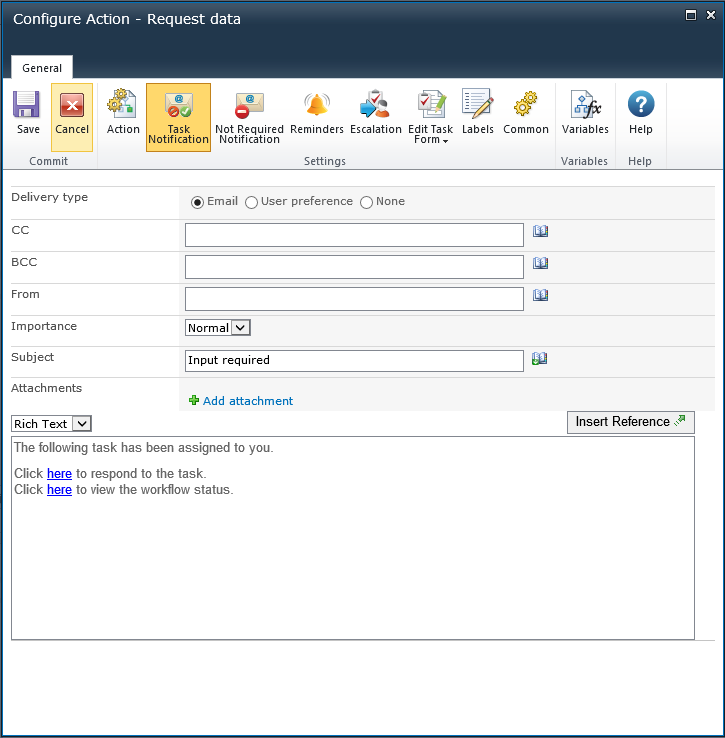
Delivery type is the method of delivering the notification to the recipients.
Available delivery options; None, Email, User preference or Instant Message (if enabled on the server). For information on User preference, please refer to the Configuring user preferences.
The CC field sets read only users who will receive the notification. CC recipients are not able to respond to the tasks.
To set the CC field click on
to open the Select People and Groups configuration dialog.
The BCC field sets read only users who will receive the email. BCC recipitants are not able to respond to the tasks. Other users addressed in the email via the To, CC and BCC fields will not be able to see any addresses in the BCC field. To set the BCC field, enter the account name, or alternatively, select the address book icon for additional options.
The From field sets the user or domain group that will appear as the sender of the message. This setting applies to emails only. If no From user or domain group is specified, the From address configured in Global Settings will be used.
The priority of the notification. This is only applicable when using email notifications.
The Subject is the title of the notification being sent. Manually enter the text or click the
button to use Insert reference fields to build the string dynamically at run time.
Allows file attachments to be added to the notification. You can specify multiple URLs by separating each URL with a semicolon. You can also specify multiple URLs by referencing a collection variable.
Files will not be received by a user when SMS or IM is selected as the delivery method. For information on User preference, please refer to the Configuring user preferences.
This sets the format of the email.
Selecting:
The body of the notification will adapt depending on whether the Rich Text or Plain Text format is selected. Within the space provided enter the content for the notification as straight text and Inserting reference fields from with the workflow.
Sent when the user no longer needs to respond to the task. This can occur when:
- A task is assigned to multiple users but only one is required to respond.
- The workflow is terminated prior to the task being processed.
- An error occurs in the workflow at runtime.
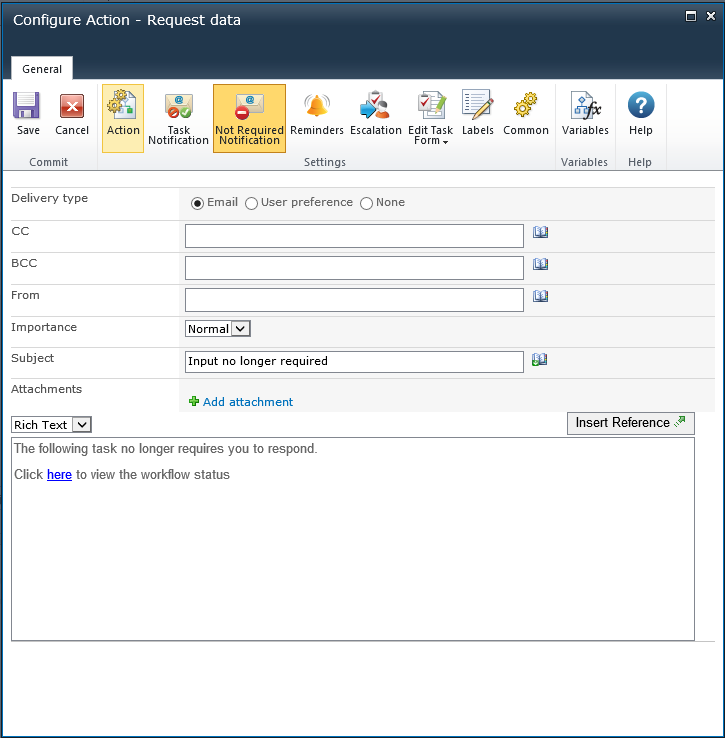
See Ribbon Option: Task Notification above for field descriptions.
Optional notification Reminders can be configured to be sent to each assignee who has not yet completed the task.

The number of reminders to be sent.
The delay before sending each reminder in days, hours and minutes.
The total time is calculated by summing all fields, regardless of the Time calculation option selected. For example, 4 days and 4 minutes will be calculated as 96 (24x4) hours and 4 minutes.
Specifies whether or not hours outside the work week should be included when counting down to send a reminder.
The During business days only option will specify that weekends or holidays are not included in the countdown, but after hours on a business day are.Example:
- The task is assigned Friday morning and is configured to wait 1 day before sending a reminder (the work week is defined as Monday to Friday).
- A reminder will be sent Monday morning: weekends are not included in the countdown.
The During business hours only option specifies that only business hours are used in the count down.Example:
- The task is assigned Wednesday at 4pm and is configured to wait 4 hours before sending a reminder (the work day is defined as Monday to Friday, 8am to 5pm).
- A reminder will be sent at 11am on Thursday: after-business hours are not included in the countdown.
If neither option is selected, all hours will be included in the count down.
Examples:
- The task is assigned Friday morning and is configured to wait 1 day before sending a reminder.
- A reminder will be sent Saturday morning: weekends are included in the countdown.
- The task is assigned Wednesday at 4pm and is configured to wait 4 hours before sending a reminder.
- A reminder will be sent at 8pm on Wednesday: after-business hours are included in the countdown.
Public holidays and any other special occasions are set using the "Site Settings > Nintex Workflow > Manage Holidays" page.
See Ribbon Option: Task Notification above for additional field descriptions.
Escalation is optional, there are two possible escalation paths:
- Delegate task will re-assign all pending tasks to the nominated user after the specified time.
- Complete task will automatically complete the task.
Escalation occurs after all reminders have been sent and the specified "Time to escalation" has elapsed.
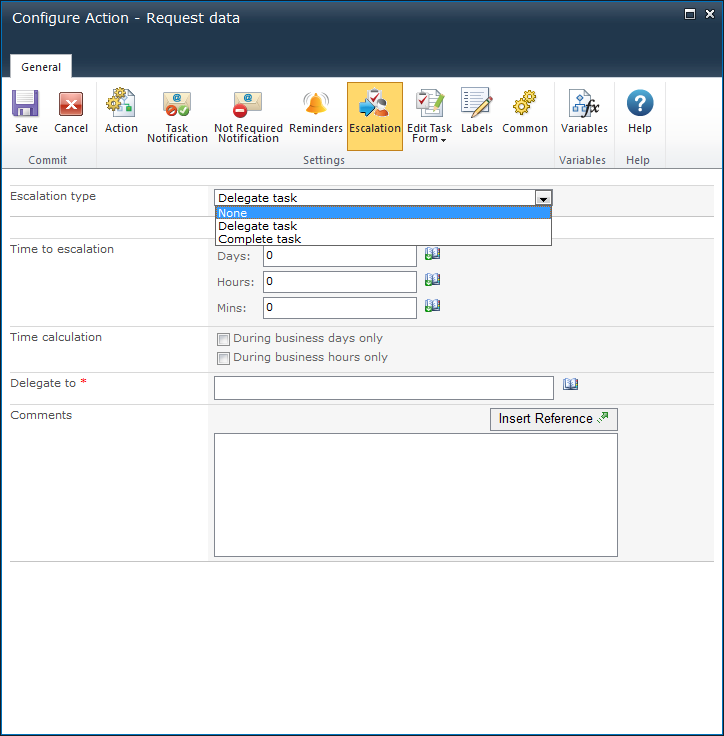
See Ribbon Option: Reminders above for additional field descriptions.